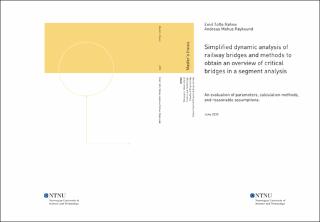| dc.description.abstract | The main purpose of this thesis is to study the possibility to perform dynamic analyses of multiple railway bridges with limited input. Upgrading railway lines for high speed trains is common, and being able to get an overview over critical bridge lengths and train velocities without performing complicated analysis on every single bridge would be useful.
Nerk is a new German software meant to provide an overview of response based on bridge type and bridge length. It uses assumptions from the Eurocode in terms of damping and eigenfrequency, simplifies the train load as a set of constant moving forces and assumes all bridges to be simply supported. This is used to construct 3D plots with response as a function of train velocity and bridge length. Back-end programming of Nerk has been performed in MATLAB to study individual parts of the software, which is used to evaluate the assumptions and possible alternatives. An extensive number of bridges are used for the assessment of Nerk and for the development of an alternative. Further on complex systems and more detailed bridge models are studied to assess the sufficiency of the analysis.
The results show that the assumptions in Nerk are highly conservative, and that the response obtained is hard to interpret and use for further analysis. The Roehnsund method is introduced as an alternative to assume mass and stiffness, and gives results closer to analytical response using exact properties. A MATLAB script using Roehnsund method and calculation model from Nerk is developed and tested, making it simple to analyze a set of bridges, construct 3D-plots and perform better analyses. Generally, the shape of response against velocity (MAC) is good for the calculation method used, while the value of the response is not consistently close to correct (Mean ratio above 1). Hence the results obtained are evaluated as good for obtaining an overview of critical lengths and velocities, but more detailed calculations should be made for these cases. Additionally, the mean ratio grows for bridges that deviate from the assumption regarding single span and simply supported, generally causing more conservative results. | |
